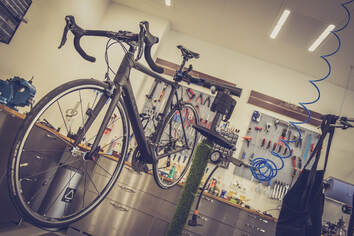 There are options for getting your bike in top shape and they begin in the off season. Some people think the 2018 bike season is on hold until Spring, but it actually starts now, according to a panel of speakers at the January 16, 2018 Evanston Bike Club monthly meeting. If you need a new bike, part, or accessory good deals are available this time of year. An indoor trainer is good way to prepare for riding outdoors. This is also the ideal time to get your bike in prime mechanical shape. The panel addressed common bike maintenance models—do it yourself, engage a professional in a traditional bike shop or the mobile bike repair option. Cons Gattuso is a self-taught home mechanic using YouTube and other web resources, such as the Park Tool web site, to educate himself, although he occasionally engages professional bike technicians if he encounters a situation requiring expertise or tools he does not have.
Con’s observations: · Newer bikes are easier to work on because components are interchangeable and if your bike has electronic shifting there are less cables exposed and thus less maintenance · His favorite “bike shop” is where he purchases general purpose tools: Home Depot · His home workshop contains a torque wrench, torque driver, set of hex wrenches, a bike stand, chain measurement tool (to know if the chain is stretched) and disposable gloves · He follows the pseudo German phrase for all screws and bolts: guten tight (i.e. good and tight) · To lubricate his chain he uses wax purchased in bulk which he melts using a heater from a beauty supply store · He levels his saddle using a laser · A sonic parts cleaner does a good job cleaning small parts · On the road he carries basic tire changing tools in his jersey pocket Ben Schapiro, co-owner of Everyday Cycles, 941 Chicago Ave, Evanston, veloben@comcast.net liked to work on his bike growing up and has auto mechanic experience. He believes the bike is basically a simple machine that does not hide anything. Ben’s observations: · A bike shop’s biggest investment is in tools; There are few standards in the bicycle industry so shops have specialized tools to service the large variety of components · When a bike comes into the shop the intake process is to put it in the bike stand and do a complete assessment of the brakes, cables, tires, chain and shifting · Important skills learned working in a bike shop is how to research what parts to order and developing connections to suppliers for advice · Many shops have a stock of test saddles to let you try for a few hundred miles of riding before you buy since you cannot tell if a saddle will be comfortable by looking at it or just riding it around the block · The advantage of taking your bike to a professional technician is that they have the tools and time to work on your bike and the experience to identify operational and safety issues before they become serious Phil Sandler is owner of the mobile bike repair Velofix Chicago North Shore, 630-327-7949, phil@velofix.com. Phil started biking as a child, but got the bike bug while preparing for the North Shore Century in 2009. His Mercedes sprinter van is equivalent to a full service bike shop at a compact 100 square feet. He is a certified bike technician and bike fitter and he and his van will come to you for bike tune ups, emergency service, bike fits, and bike sales. In an industry looking for ways to reach out to consumers accustomed to buying online this model is growing fast. Phil’s operating hours are 7am to 9pm, 7 days a week. Phil’s observations: · A well-fitting bike should disappear underneath you · In the pedal/foot interface there are 5 different adjustments to optimize your power and comfort · A bike tune up can range from a basic safety check, on-bike wheel truing, and brake and shift adjustments to more thorough off bike wheel truing, cleaning including a sonic parts wash, to replacement of worn cables and housing at the high level · To clean your bike, spray with soap and use a soft bristle brush, wipe down the chain (but use a chain cleaning kit if it is very dirty), rinse with isopropyl alcohol to get all the oils and grease off, then re-lubricate the chain · Lube comes either as dry (like wax that does not attract dirt from the road) or wet · On his bike he carries in a seat bag a spare tube, two CO2 cartridges and a chuck, tire boot, duct tape, tire patches, multi-tool, plus one tire lever With all these options it is easy to have a clean and functioning bike ready for your next ride whether that is today or the next sunny, 60 degree day. Comments are closed.
|
Earth Rider Blog about CycingAuthorSharon Kaminecki and others comment on adventures in bicycling and other stories Categories
All
Archives
August 2023
|


